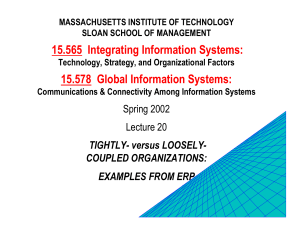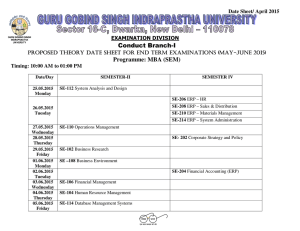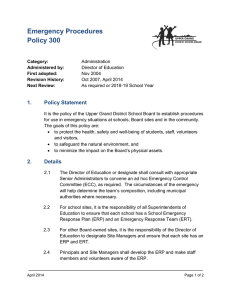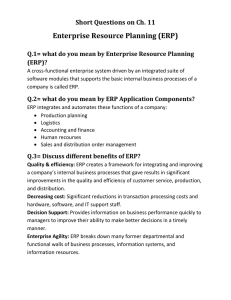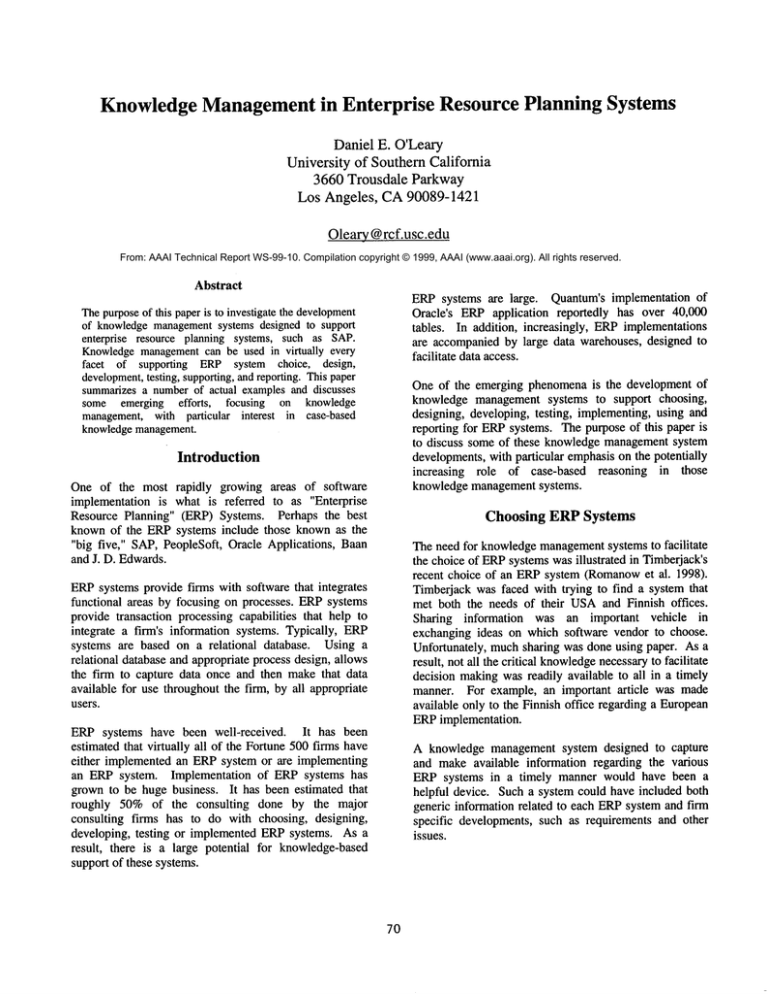
Knowledge Managementin Enterprise Resource Planning Systems
Daniel E. O’Leary
University of Southern California
3660 Trousdale
Parkway
Los Angeles, CA 90089-1421
Oleary @ rcf.usc.edu
From: AAAI Technical Report WS-99-10. Compilation copyright © 1999, AAAI (www.aaai.org). All rights reserved.
Abstract
ERP systems are large. Quantum’s implementation of
Oracle’s ERPapplication reportedly has over 40,000
tables. In addition, increasingly, ERPimplementations
are accompanied by large data warehouses, designed to
facilitate data access.
Thepurposeof this paperis to investigate the development
of knowledgemanagementsystems designed to support
enterprise resource planning systems, such as SAP.
Knowledgemanagementcan be used in virtually every
facet of supporting ERP system choice, design,
development,
testing, supporting,and reporting. Thispaper
summarizesa numberof actual examplesand discusses
some emerging efforts,
focusing on knowledge
management,with particular interest in case-based
knowledgemanagement.
One of the emerging phenomena is the development of
knowledge management systems to support choosing,
designing, developing, testing, implementing, using and
reporting for ERPsystems. The purpose of this paper is
to discuss some of these knowledge managementsystem
developments,with particular emphasison the potentially
increasing role of case-based reasoning in those
knowledge managementsystems.
Introduction
One of the most rapidly growing areas of software
implementation is what is referred to as "Enterprise
Resource Planning" (ERP) Systems. Perhaps the best
known of the ERPsystems include those known as the
"big five," SAP,PeopleSoft, Oracle Applications, Baan
and J. D. Edwards.
Choosing
ERP Systems
The need for knowledgemanagementsystems to facilitate
the choice of ERPsystems was illustrated in Timberjack’s
recent choice of an ERPsystem (Romanowet al. 1998).
Timberjack was faced with trying to find a system that
met both the needs of their USAand Finnish offices.
Sharing information was an important vehicle in
exchanging ideas on which software vendor to choose.
Unfortunately, muchsharing was done using paper. As a
result, not all the critical knowledge
necessaryto facilitate
decision makingwas readily available to all in a timely
manner. For example, an important article was made
available only to the Finnish office regarding a European
ERPimplementation.
ERPsystems provide finns with software that integrates
functional areas by focusing on processes. ERPsystems
provide transaction processing capabilities that help to
integrate a firm’s information systems. Typically, ERP
systems are based on a relational database. Using a
relational database and appropriate process design, allows
the firm to capture data once and then make that data
available for use throughout the firm, by all appropriate
users.
ERP systems have been well-received.
It has been
estimated that virtually all of the Fortune 500 firms have
either implemented an ERPsystem or are implementing
an ERP system. Implementation of ERP systems has
grown to be huge business. It has been estimated that
roughly 50% of the consulting done by the major
consulting finns has to do with choosing, designing,
developing, testing or implemented ERP systems. As a
result, there is a large potential for knowledge-based
support of these systems.
A knowledge management system designed to capture
and make available information regarding the various
ERP systems in a timely manner would have been a
helpful device. Such a system could have included both
generic information related to each ERPsystem and firm
specific developments, such as requirements and other
issues.
70
has been a push to makeERPreport information available
on corporate intranets (O’Leary 1999b). As a result, ERP
report information increasingly is being treated as part of
firms’ knowledgemanagementsystems.
Implementing ERPSystems: Support for
ImplementationDifficulties
Developing ERP systems requires that both users and
developers coordinate their efforts. As users find
problems they need to make the developers aware of
those problems and developers need to find solutions. In
somecases users mayhave the same or a similar problem.
If the problemhas been solved, then users need to be able
to find out about the previous solution. If the problemhas
not yet been solved, but others have the same problem,
then there needs to be a coordination of efforts, because
otherwise resources will be misallocated with the
developmentof duplicate solutions.
In the case of Microsoft, expert users were expected to
use the reporting capabilities
of the ERP system.
However,for less expert and casual users, a wide range of
information generated from the ERPwas made available
on the intranet. In addition, to makingthe information
widely available, the moveof information to the intranet
minimizedERPcosts that Microsoft incurred, since those
costs werebased on a per seat level of usage.
Developing Data for Input to ERPSystems:
Support for Financial Transactions
Case Study
Using ERPsystems requires that the user be aware not
only howto use the system, but also understand what they
want to do with the system. In order to get users the
knowledge that they need to do their job, a number of
firms have made"help" available over the intranet.
As part of the development of an ERP, a consultant had
developed a knowledge base that would capture of
problems and allow tracking of their solution (O’Leary
1999a). As noted by the consultant during an interview
Financial Transactions
(The system is used to)...categorize
problems
issue category, e.g., training, system, network,
PeopleSoft Configuration Set Up, PeopleSoft
Module, etc ....
a user logs in an issue with
information, such as which module, process, screen
shot .... (that is the source of the problem). Then,
consultant opens it to solve the problem .... Any
progress or resolution to an issue will be logged into
this database .... This way ... the project can have
better resource allocation planning.
ERP financial modules require that users be able to
provide transaction information for use in the system.
Unfortunately, transactions vary in their difficulty. I
interviewed somefinancial system users that indicate that
developmentof transactions for entry into the system can
be very difficult. In somecases, only experts are able to
develop those entries. As a result, there is interest in
developing system support for those users. For example,
recently I had a conversation with a representative of one
of the big five ERPfirms whoindicated that their firm
was interested in obtaining knowledge-basedsupport for
those personnel makingfinancial systemtransactions.
Originally, the system was developed in order to provide
a quick fix to track an overwhelming number of user
support requests. In addition, there had been duplicate
inquiries that ultimately led to redundantefforts, that the
knowledge management system now minimized.
However, the system has been so useful that the client
planned to continue to use the system. Future plans
included changing the computing environment, migrating
the system to Lotus Notes.
Unfortunately, there has been limited research to-date on
formal knowledge representation
of transaction
knowledge to guide development efforts. Perhaps the
only paper to model the knowledge-basedrepresentation
of financial transactions is O’Learyand Kandelin (1992).
They developed a domainspecific natural language-based
system that understood accounting language and was able
to use that understanding of events in order to generate
the resulting financial transaction entries.
This knowledge base is now being extended. A casebased system is nowbeing designed, couching the data as
cases in order to more fully exploit machineprocessing
capabilities of the cases.
Transaction Characteristics
ERP Reporting Systems
An important characteristic of financial transactions is
that they tend to repeat themselves. For example, an
overwhelmingmajority of a firm’s financial transactions
are purchases or sales. Within these two types of
transactions there is substantial similarity. The basic form
Unfortunately (fortunately?), reporting systems for ERP
systems are generally perceived as difficult to use.
Starting with Microsoft’s implementation of SAP, there
71
Data warehouses open up additional opportunities for
knowledge management and case-based reasoning. In
particular, knowledgediscovery can be used to exploit the
extensive data availability in a data warehouse.
of all purchases is roughly the same, including either a
cash disbursement and a purchase or an accounts payable
and a purchase. "Purchases" is a generic account
sometimes replaced by an account representing the
specific item purchases, such as materials or a particular
kind of materials. This repeating nature leads us to
suggest that a case-based reasoning approach is an
appropriate vehicle to capture and represent knowledge
about financial transactions.
Extensions
This paper has focused on knowledge management for
choosing, implementing, using and reporting in ERP
systems. However, knowledge management systems
could also be developed for other aspects of ERPsystems,
such as, designing, developingand testing.
Althoughtransactions basically "repeat themselves" they
are not always identical.
Case-based reasoning is
necessary because, for example, previously stored
financial transactions may need to be modified to make
new transactions and/or new transactions does not match
100%any of the previously stored transactions and thus a
selection must be madebased on partial match.
A prototype system design was presented for capturing
case-based knowledgeabout financial transactions. The
case base in support of that system is minimal and could
be further extended.
Summary
A Prototype System
Using the M.4 shell, we developed a preliminary system
design that exploits the basic underlying database
requirementsfor financial transactions (see exhibit 1 for
sample case and a few rules). In particular, research
suggests that ERPsystems employa database schema that
generates information on resources, events, agents and
locations from the financial transactions (O’Leary, 1998).
Case attribute information is captured based primarily on
the events for which the system is designed to process.
Additional information in the cases includes the resource
(e.g., cash) and the direction of change in the resource
(e.g., cash increasing), the external agent (e.g.,
particular client) and the location for which the event is
occurring (e.g., central office). In addition, the resulting
financial systementry, in terms of debits and credits also
is captured.
Enterprise resource planning (ERP)systems are receiving
widespread attention. Knowledge management systems
are being developed to facilitate
use of those ERP
systems. This paper has investigated
some of the
relationships
between ERP systems and knowledge
managementsystems, with a focus on the opportunities
for use of case-based knowledgerepresentations.
References
O’Leary, D., "SAP is REAL,"paper presented at SMAP
98, NewOrleans, August 1998.
O’Leary, D., "James O’Leary Travel Services, III: A
Second PeopleSoft Implementation," Unpublished Case
Study, University of SouthernCalifornia, 1999a.
Data Warehousesfor ERPSystems:
Creating Knowledge
O’Leary, D., "Microsofl’s
Reporting in SAP,"
Unpublished Case Study, University of Southern
California, 1999b.
Increasingly, firms are makingERPinformation on their
intranets. However, typically, ERP-based reports are
designed for a single month,quarter, or year. As a result,
some users are nowinterested in longer time frames of
available data. As a result, firms are implementingdata
warehousesto facilitate access to a broader range of the
data over longer time periods, such as multiple years.
O’Leary, D., and Kandelin, N., "Accountant: A Domain
Dependent Accounting Language Processing System," in
Expert Systems in Finance, D. O’Leary and P. Watkins,
1992, Elsevier.
Romanow,D., Keil, M. and McFarlan, W., "Timberjack
Parts: Packaged Software Selection Project," Harvard
Business
School,
February
25,
1998.
72


